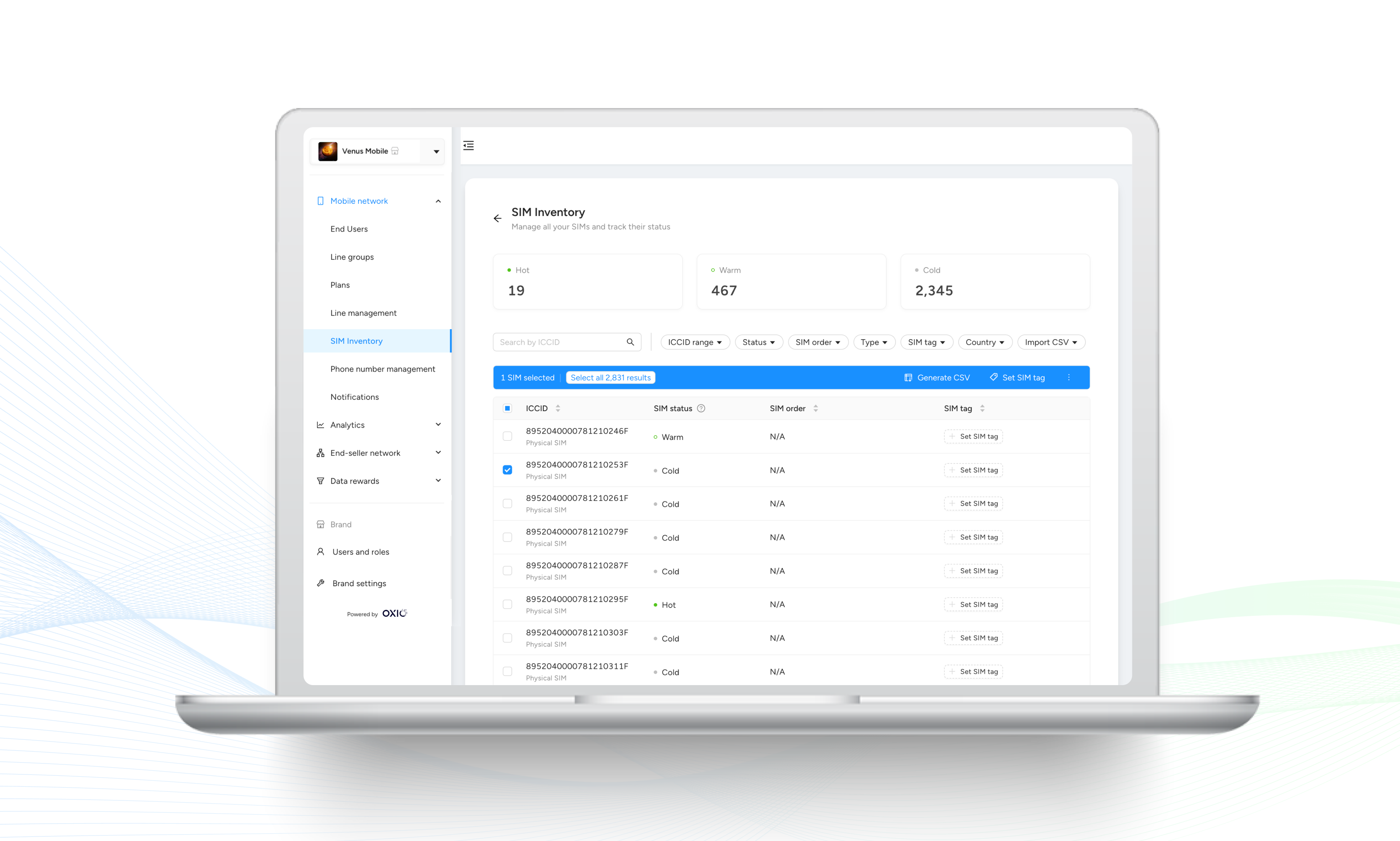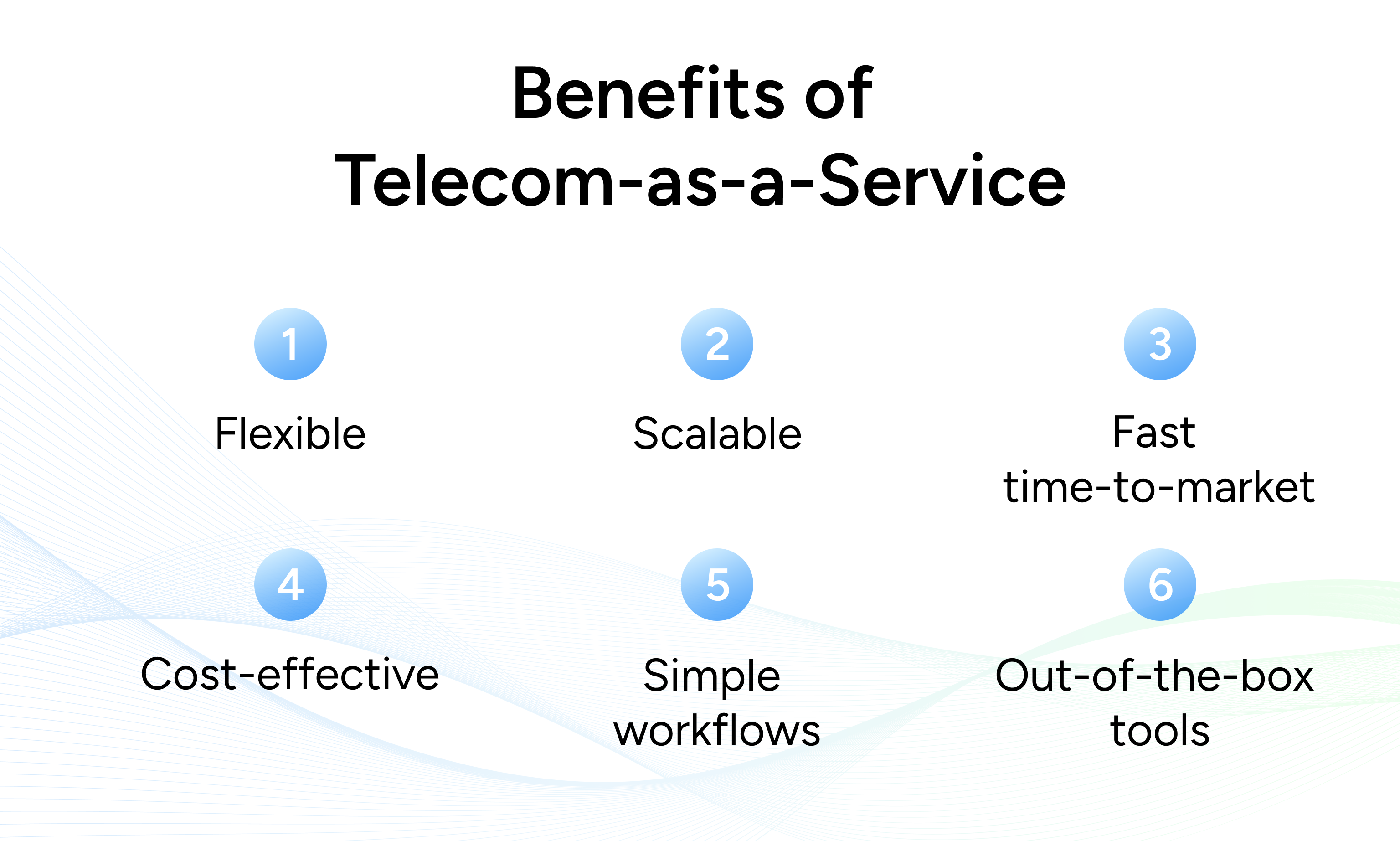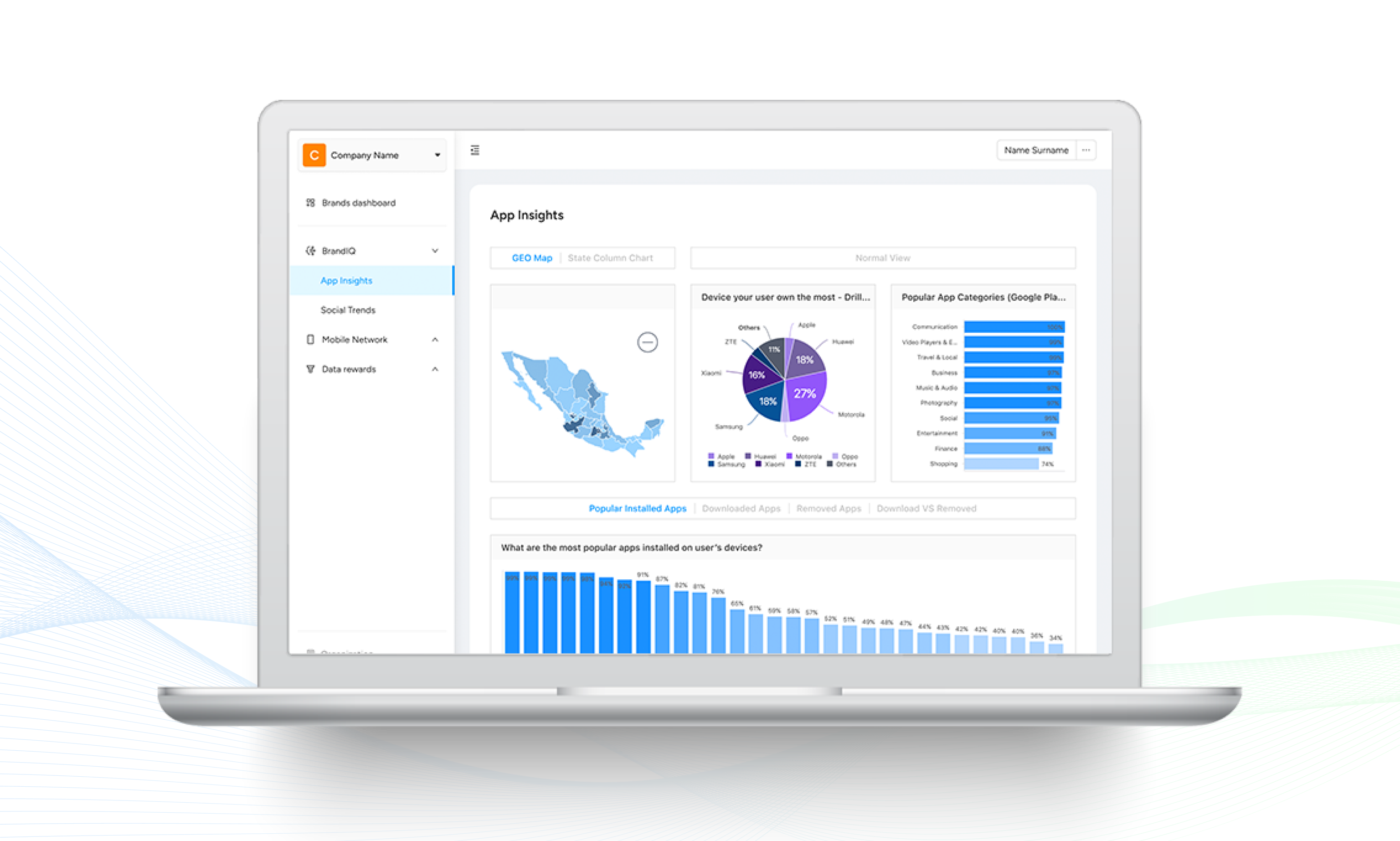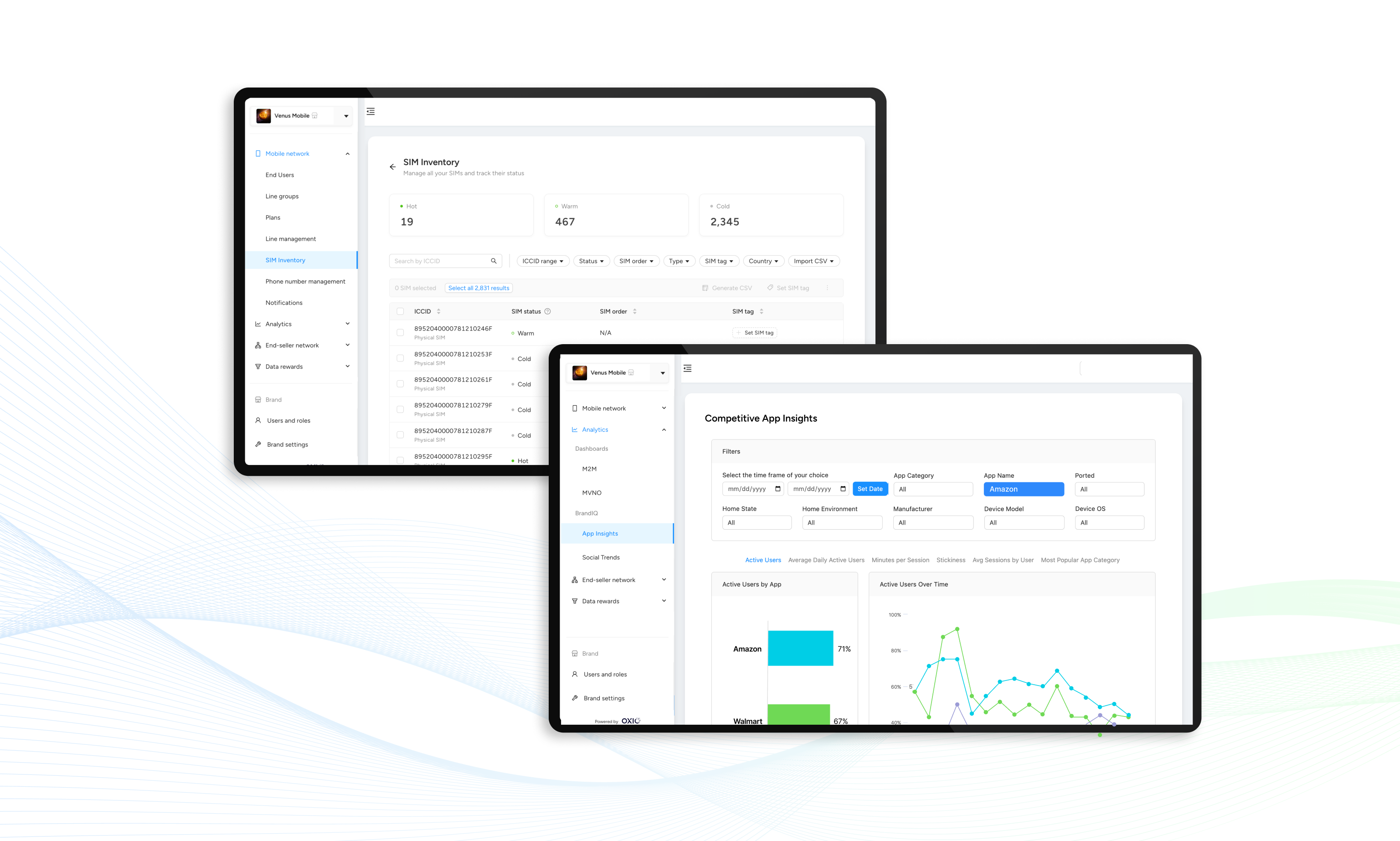What is Telecom-as-a-Service (TaaS)?
Telecom-as-a-Service (TaaS) is a cloud-based telecom delivery model, where the provider productizes telecom into one simple platform that’s made available via an online subscription model.
TaaS removes the traditional complexities of telecom, delivering global telecom capabilities at scale via simple APIs and tools. TaaS providers pull existing telecom networks into the cloud, where they can be quickly and easily accessed by any business or individual seeking to offer telecommunication services to their customers and audiences, and deploying like any modern SaaS solution, with no telecom experience required.
TaaS eliminates the costly need to own and maintain the underlying infrastructure, hardware and software that are necessary to operate traditional mobile networks, empowering TaaS users to offer mobile connectivity to customers quickly, efficiently, cost-effectively and with more flexibility than has ever been seen before in telecom.
Advanced TaaS models offer brands and enterprises a pre-integrated and automated solution, giving them everything they need to launch an MVNO from the very first day of their partnership and removing the time constraints typically associated with working with multiple mobile carriers.
The journey to Telecom-as-a-Service
TaaS is a fairly new, but exciting, concept in the world of telecom delivery, but it’s been a long road to get the market to where it is today.
MNOs have been trying to repurpose their assets since the late 1990s, when the addition of MVNOs was first seen in the market as a way for MNOs to access new subsets of customers where they had little existing traction – and the journey to the cloudification of connectivity really began there.
Many MNOs have had an enablement arm of their business on the wholesale side for some time now, which has allowed multi-tenant applications to enable others to leverage their assets. When this was first introduced, everything was still being run on premise and the intellectual property was still very much owned by the MNOs. The industry then started to see a segue to things moving into the public cloud sphere and computers started to get more powerful, which opened up a door for other players to start entering the market and the concept of cloud connectivity and Telecom-as-a-Service started to be explored and developed.
The need for global, ubiquitous connectivity surged as businesses looked for faster, smarter and more efficient ways of connecting machines and devices in the machine-to-machine world. We saw many different platforms like Twillio and Telit quickly rise in the world of M2M, with M2M connectivity being much easier to bundle into the cloud with data-only solutions.
Soon, the idea of bundling not only data, but voice and SMS, into the cloud started to gain traction and companies like OXIO were launched in the late 2010’s.
The rise of Telecom-as-a-Service
Telecommunications is one of the last industries to be truly disrupted in the digital age. The retail industry had Amazon, financial services had Stripe, transportation had Uber, and hospitality had AirBnB– all of these phenomenally successful companies have disrupted industries through the power of cloud transformation and automation. These innovative disruptors automated and simplified outdated legacy systems in favor of cloud-based, asset-light models, and telecom will be next to transform with the advent of Telecom-as-a-Service.

Similar to how Uber doesn’t own the roads or cars it uses, and AirBnB doesn’t own the dwellings it rents, TaaS leverages the physical telecom infrastructure of the world’s mobile operators to remain agile and asset-light.
The continued adoption of the Telecom-as-a-Service business model has been driven by several factors seen in SaaS , including cloud infrastructure innovations, a mobile-first approach to technology, improved use of data and AI, the platformization of technology, integration developments and better data security. SaaS has evolved significantly over the last decade and will continue to be a key driver of digital transformation and innovation that benefits the world of TaaS, in years to come.
How does Telecom-as-a-Service work?
Similarly to how SaaS works, TaaS works through a cloud delivery model where the platform is accessed by its customers via an API or web browser.
TaaS pulls connectivity to the cloud where it can then be accessed and deployed by brands and enterprises via a turn-key platform. Most TaaS providers are resellers that offer out-of-the-box carrier APIs to customers through a modern online interface that improves time to market. This is a great option for companies who need fast access to data with few technical requirements or customizations. For customers seeking full control and customization of their customer network experience, as well as integration into existing technology products, there are some TaaS providers who integrate deeply with MNOs at the RAN-level. TaaS providers of this nature, like OXIO, are uniquely integrating with the world’s best mobile carriers to provide more customization, flexibility and control to customers via a single source of connectivity. Only TaaS providers who build their own global telecom core in the cloud will be able to deliver this kind of sophisticated offering. This also gives customers the ability to mix-and-match MNOs worldwide to give their end-users the best possible coverage at all times while also accessing highly customizable features, functionality and business intelligence.
The concept of roaming is also eliminated by the more deeply integrated TaaS providers, like OXIO- something that has plagued international travelers for years and has often led to unwanted ‘bill shock’ at the end of vacations or business travel. General TaaS providers will mainly depend on individual roaming agreements for each country that they operate in, in order to offer end-users a more cost-effective connectivity solution when traveling, with travel eSIMs being used widely. However, with a TaaS provider like OXIO, that will provide customers with a global network on a single SIM, roaming will be eliminated as travelers will automatically and seamlessly switch to local carriers in the country they travel to, meaning they are treated as ‘local’ even if their phone contract is purchased elsewhere. For example, if you are a US citizen traveling to Europe and you have purchased your phone plan with a US MVNO, when you travel to a destination in Europe, your data, voice and SMS usage will be treated as if you were still at home in the US, with no hidden tariffs or costs.
This also has huge benefits for those MVNOs who are shipping devices and SIM cards around the globe, or bundling devices and SIMs as a packaged deal. Working with a more superior TaaS provider, would mean devices and SIMs shipped from overseas would have the ability to connect automatically to a local network anywhere in the world, without the complexity of the MVNO managing relationships with international carriers or dealing with difficult SIM management. TaaS providers who have their own global core, will have already dealt with the underlying complications associated with carrier relationships, regulations and contracts, enabling MVNOs or companies looking to sell or embed connectivity to simply plug ‘n’ play and operate seamlessly anywhere in the world.
TaaS architecture

TaaS software platforms are designed to expose on-demand telecom services and insights to any business, brand or individual. They generally have a layered infrastructure and are built on a modern stack of APIs, webhooks, and events that can be managed through user focused interfaces, where TaaS clients can interact directly with telecom networks, services and functions. TaaS providers will typically keep privacy, security and scalability top of mind when developing and maintaining functionalities within their platform.
Like any modern SaaS solution, TaaS providers use a multi-tenant approach where a single instance of the TaaS application will be running on the host servers, and that single-instance will serve each individual TaaS customer. Each individual organization will be configured separately on the platform, where that organization can go in and create their own MVNO brand(s), but where their information and data is segregated and separated from other organizations on the TaaS platform.
What are the characteristics of Telecom-as-a-Service?
TaaS exhibits several key characteristics that define its nature and distinguish it from traditional telecom models. These characteristics include:
Cloud-based delivery – TaaS is delivered through cloud-based systems, enabling users to access services remotely over the internet, eliminating the need for on-premise hardware or infrastructure and helping to drive scalability and accessibility.
On-demand service – TaaS generally operates on a subscription or pay-as-you-go model with flexible and use-case specific pricing options e.g. data pooling, giving users a cost-effective solution and allowing them to scale services based on their immediate needs.
Speed-to-market – TaaS empowers unrivaled speed to market for users selling, subsidizing or embedding connectivity into their offering. With pre-integrations and automation, TaaS gives users everything they need to start selling connectivity immediately.
Scalability and flexibility – Users can easily scale services up and down depending on their requirements and strategy, accommodating changes in business demands without the need for major infrastructure adjustments. Custom plans, with features like zero-rating, can be created in minutes and require no outside permissions or development.
Reduced capital expenditure – By leveraging TaaS, businesses don’t need to invest in the infrastructure of physical telecom, reducing upfront CapEx.
User-experience focus – TaaS platforms often prioritize user experience, providing easy-to-use interfaces and functionalities that enhance collaboration and communication amongst its users and enabling businesses to have a customer-first mindset with the end customer experience being the core focus.
Customization and integration – TaaS services are often customizable, allowing businesses to integrate telecom services with other software and systems, such as CRMs or ERPs, to streamline operations, ensure holistic data syncing across the business and improve overall efficiency.
Security – TaaS providers implement robust security measures to protect data and ensure secure communication, often implementing a privacy-first culture that focuses on adhering to privacy guidelines set out by the likes of GDPR, ARCO, CCPA, LGPD and other localized governing bodies.
Continuous innovation – TaaS providers continuously update and innovate their services, ensuring their users have access to the latest and greatest features and functionality that keeps them on the cutting edge of technology.
These characteristics collectively define the nature of TaaS, offering businesses, brands and individuals an adaptable, cost-effective and versatile approach to accessing and offering telecommunications services that has never been seen before.
What are the benefits of Telecom-as-a-Service?
The traditional methods and legacy models of telecom are manual, and not built for rapid change and innovation. Companies in industries like retail and fintech, have seen the value in telecom and adding connectivity into their offering, but have had no idea how to make it a reality. In addition to the slow moving pace of telecom, which does not meet the lightning-speed requirements of retail and fintech, telecom has been too hard, too complicated, too expensive and too overwhelming to consider as a viable new strategy for enterprises – until now.

TaaS is making telecom simple. The complexities of traditional telecom are a thing of the past with TaaS, giving companies the freedom and flexibility to offer mobile services to customers in new and exciting ways, where connectivity can be embedded into their core offering. Here are some of the leading benefits of TaaS, that make this type of technology so powerful and compelling:
Stronger coverage on a smarter network – With a network from the cloud, sophisticated TaaS companies can offer a true multi-carrier platform without roaming charges, where networks are blended and consumers get access to the best possible network, wherever they’re located.
Turnkey software – TaaS providers can offer unparalleled speed to market on custom plans and connectivity solutions that delight customers and drive retention, loyalty and satisfaction.
Lower fixed cost – With no network infrastructure to build and maintain, the barriers to enter the telecom market with TaaS are effectively eliminated and upfront costs to launch an MVNO are dramatically reduced. Using TaaS to launch an MVNO is far more cost-effective that the traditional approach of working with an MNO directly, or through an MVNE, using a pay-as-you-grow approach.
Increased business flexibility – TaaS providers who invest heavily in building their own global core and cloud platform, where an API first approach to telecom is deployed and maintained, can act as a global telecom partner for enterprises, allowing companies to be in the driver’s seat of their telecom experience with unmatched flexibility, customization and personalization.
Customer-centricity – With TaaS, you can become truly customer-obsessed, where every decision you make around connectivity is based on the end-user experience. TaaS providers that deliver data as part of their services will empower you to understand your customers in ways you didn’t think were possible, where you can start marketing to your subscribers as a market of one, helping to exceed customer expectations and drive unparalleled loyalty.
Accessing unique end-user telecom and behavioral data

Some deeply integrated TaaS providers, like OXIO, who connect into an MNOs core network at the RAN-level, can also provide access to first-party telecom and behavioral data that, until now, has been inaccessible to businesses. TaaS companies who connect to carriers in a full MVNO manner are able to surface unique data on subscribers that can be delivered to businesses through actionable dashboards and insights that can in turn help them fuel their strategies and marketing campaigns. Examples of this powerful network level intelligence include:
Network data – Gain real-time insights and visibility into network reliability and performance, with the ability to predict and preempt service disruptions for fast remediation and proactive customer communication.
Telecom data – Powerful data around active lines, consumption, plan utilization, retention, churn predictions and more can be surfaced so MVNOs can always understand the true health of their business.
Subscriber data – Behavioral data that goes beyond app and website intelligence can be surfaced and made into insights for MVNOs, enabling them to understand social media preferences and usage, competitors, and other habits and behaviors. MVNOs are then able to build a complete 360 degree view of their customer.
This high quality behavioral data can supercharge an organization’s offering by providing a deeper understanding of customers, that enables the opportunity to intelligently upsell and cross-sell in new and exciting ways that drive customer lifetime value (CLTV) and foster loyalty.
With this kind of unique subscriber data, businesses can build detailed first-party ad profiles to sell to advertisers, provide contextual rewards and experiences to customers in real-time, improve the ability to predict and reduce churn, help fraud detection, drive better ARPU and deliver outstanding customer experiences. With TaaS providers, like OXIO, understanding your customers at a deeper level is now made easier and enables businesses to become truly customer-centric with a customer-first mind-set when it comes to connectivity.
What industries can benefit from Telecom-as-a-Service?

The benefits of Telecom-as-a-Service can extend across different industries, helping to reshape and drive innovation like never before. As industries become increasingly more competitive in the digital age, the advent of TaaS offers a new opportunity to add additional revenue streams and provide exciting customer experiences. The following industries have great potential to benefit from TaaS and bundling connectivity into existing product offerings for which they already have a strong value proposition:
Consumer brands and retail – Telecom-as-a-Service and the telecom data some TaaS providers can surface unlocks new ways for retail and consumer brands to be competitive. By offering mobile services in parallel with their core offering, brands can stay connected to customers outside of the traditional in-store and in-app interactions, helping retailers to embed themselves in a consumer’s day-to-day life, driving increased loyalty and retention.
Fintech – This industry can explore adding connectivity into its offering and gaining access to new and insightful telecom data on customers, to power new use cases like mobile credit scoring and risk management. We’re already seeing neobanks, like Revolut and Nubank, adding connectivity into their offerings to customers, and this is just the beginning for telecom and fintech.
Lifestyle and influencer brands – With consumer trust in celebrity brands at an all time high, influencers, content creators and celebrities can extend the reach of their brands by creating their own MVNO telecom network, giving them instant access to their fans and followers on their mobile devices. By partnering with a Telecom-as-a-Service provider, celebrities and influencers can become their own marketing channels, with a direct line of communication with their fans and audiences at all times.
Existing MVNOs – The traditional rigidity and expense of telecom that MVNOs have been exposed when working with MNOs, is eliminated with TaaS. MVNOs can enjoy unprecedented control and flexibility by working with TaaS providers, enabling them to personalize plans and deliver new experiences to customers with ease, helping to drive a competitive edge in the ultra-competitive MVNO market.
Machine-to-Machine (M2M) – As businesses continue to seek faster, smarter and more efficient ways to connect their machines and devices M2M organizations can benefit from TaaS providing them with consistent and reliable connectivity. Having the ability to manage, track and monitor device behavior and data consumption with TaaS will all be crucial for M2M businesses.
Mobile Network Operators (MNOs) – In addition to industries, MNOs are also able to benefit from TaaS technology to improve the services they offer to their wholesale customers, improve their global footprint and innovate rapidly.
What are the challenges and risks of Telecom-as-a-Service?
As with any software solution, adopting Telecom-as-a-Service will pose some potential challenges. Users of TaaS may rely on their provider to keep their software up and running, ensure country to country regulations and rules are applied, provide accurate billing and ensure all data, both on the business and customer side, is kept in a secure environment.
As with any cloud solution, the more sophisticated the technology of the vendor, the more unlikely it is that you will come up against the risks and challenges highlighted in this section.
Reliable service– Contingent on the TaaS provider a company selects, there will be an element of risk when it comes to service reliability and the ability to seamlessly switch between providers on the back-end, if a carrier’s wireless service was to go down or get disrupted.
- Using a TaaS provider who integrates with a mobile carrier at the RAN-level and controls their own core network, will reduce this risk considerably as they will have the ability to seamlessly switch network providers for customers at the backend, without the customer ever knowing a switch has occurred.
Security – As with any cloud solution, general security and data security must be well managed, and adaptable to various regulations across regions and countries – something good TaaS providers will keep top of mind.
Regulations – Companies using TaaS will have to rely on their providers’ competence in adhering to relevant laws and regulations in each country where connectivity is accessed and used.
- Choose a TaaS provider who makes data security and adherence to regulations and laws a priority and integral part of their business code of conduct
Switching vendors – Depending on the sophistication of the TaaS provider used and as expected with any cloud service provider, switching vendors could be difficult and complex when it comes to things like data migration and custom integrations and offerings.
TaaS vs. MVNE

Compared to Telecom-as-a-Service, an MVNE is purely a telecom solution and doesn’t provide any connectivity services directly to end customers. MVNEs have traditionally been seen as the connectors, or middlemen, between MNOs and smaller, ‘light’ MVNOs, who have very little flexibility when it comes to plan options, with many restrictions from the MNOs they work with.
TaaS providers won’t generally come up against these restrictions, particularly if the TaaS provider owns and controls its own core network, enabling them to offer unparalleled flexibility and control to MVNOs. Rather than waiting months to launch or customize plans, typical when working with an MVNE, TaaS providers enable MVNOs to build and launch new plans with custom features like zero-rating, in minutes.
An MVNE is an integrated platform that provides the infrastructure and OSS/BSS support needed to launch an MVNO. MVNEs provide billing systems, operations and admin support that allows an MVNO to operate without having to invest heavily in building and maintaining their own network infrastructure and business systems. Light MVNOs will often use MVNE’s to help them launch their mobile brand.
MVNEs will work with and deploy a new solution for each of their customers, individually. There is very little automation when working with an MVNE, which often means projects can take months to begin, with extensive project plans, spreadsheets and Gantt charts.
When using TaaS, businesses will no longer need to use an MVNE, as TaaS solutions bundle everything an MVNO needs to launch into one cloud-based, flexible platform, including the RAN-level network connectivity that is sold to end users. The middle man is cut out of the equation and MVNOs of varying sizes, or businesses that want to become MVNOs, can work directly with a TaaS provider to quickly make their connectivity strategy a reality.
Finally, the concept of ‘no roaming’ is made possible with some TaaS providers- something that can’t be a reality for MVNEs. Sophisticated TaaS providers who have a global network core, can offer one global SIM that works anywhere the end-user is, eliminating roaming charges and bill shock after traveling abroad.
The future of Telecom-as-a-Service
The future of Telecom-as-a-Service is likely to be driven by several key trends and developments that are expected to shape the industry. While we can’t predict specific future events, we can try to anticipate the direction and advancements that are coming our way:
5G – As 5G networks continue to expand across the globe, TaaS providers will leverage 5G’s high speed, low-latency capabilities to deliver enhanced network services and improve overall connectivity experiences for end users.
AI and automation – TaaS is likely to incorporate AI and automation into its services to deliver more meaningful customer interactions. AI will contribute to network optimizations, better call routing in contact centers, fraud detection, deeper customer analytics and insights, and improved overall service and connectivity efficiency.
Edge computing – TaaS might shift towards leveraging edge computing to reduce latency and improve real-time communication experiences. By processing data closer to the user rather than in centralized data centers, edge computing can enhance speed and reliability.
IOT connectivity – We’re already seeing TaaS providers offer M2M specific connectivity offerings that benefit the unique needs of machine-to-machine organizations. A one-size-fits-all approach to telecom does not work for M2M, so TaaS companies building out their offering to enhance M2M connectivity will help deliver significant benefits to this billion dollar, and growing, industry.
Security and privacy enhancements – As the importance of data security grows across the globe, TaaS companies are expected to focus on enhancing security measures to protect sensitive communications and customer data.
Customization and integrations – With some TaaS providers already adapting an API-first approach to telecom, the types of systems that can be smoothly, and easily, integrated will continue to grow and the APIs that are developed will continue to be as developer-friendly as possible.
Regulatory compliance – As some TaaS providers strive for a global reach, adapting to new and evolving country regulations and frameworks, as well as data protection and privacy laws, will continue to be a top priority.
Introducing OXIO – The world’s first Telecom-as-a-Service platform

Founded in 2018, OXIO is the world’s first programmable, cloud-native Telecom-as-a-Service platform that offers a one-network solution to any enterprise, brand or mobile operator who wants to monetize or embed connectivity without the constraints of traditional telecom. OXIO democratizes telecom by unbundling network service from complex physical infrastructure, pulling it into the cloud where it can be seamlessly managed and deployed like any other SaaS solution by any company or individual- with no telecom experience required.
OXIO uniquely connects to different mobile carriers in a full-MVNO manner at the RAN-level, where OXIO has complete control over its own network and the ability to offer customers infinite scaling possibilities, and unrivaled agility and speed to market.
As OXIO operates its own global, state-of-the-art network core, customers have a single source of connectivity while having the ability to unlock extensive customization, pricing, data and pre-built features that are unavailable elsewhere in the market. OXIO can surface previously inaccessible telecom data and subscriber insights for customers, so that they can be the source of their own first-party data to drive intelligent marketing, identify opportunities to up-sell and cross-sell and compete effectively in today’s data-driven world.
The OXIO platform is intelligent, secure and reliable with the unrivaled flexibility required to bring scalable connectivity experiences and business models to a market that’s currently limited by the industry’s legacy constraints.
TaaS is the future of telecom and OXIO is driving this new telecom revolution. If you’d like to speak to one of our experts on how to make your connectivity vision a reality, please reach out to us here.
